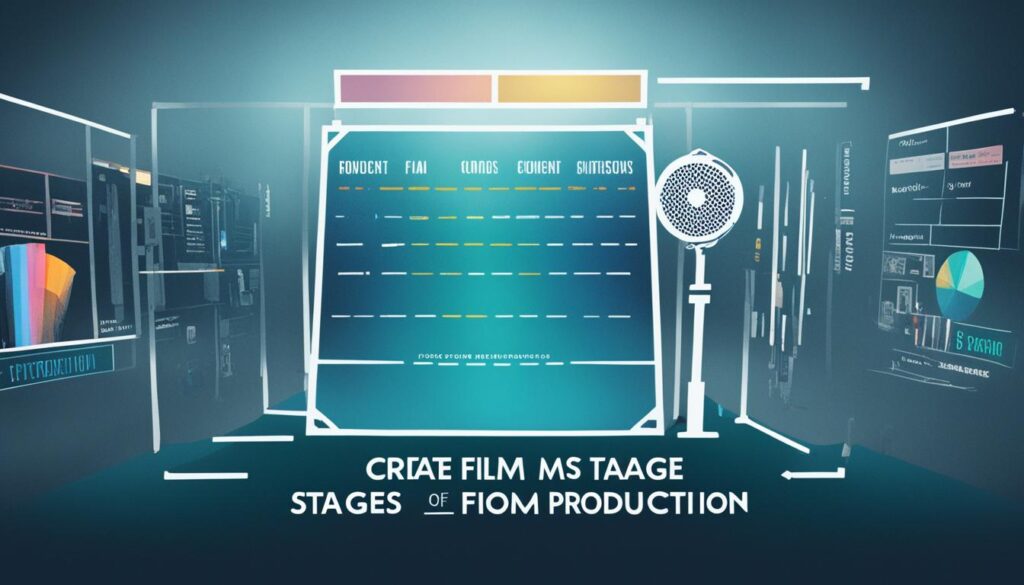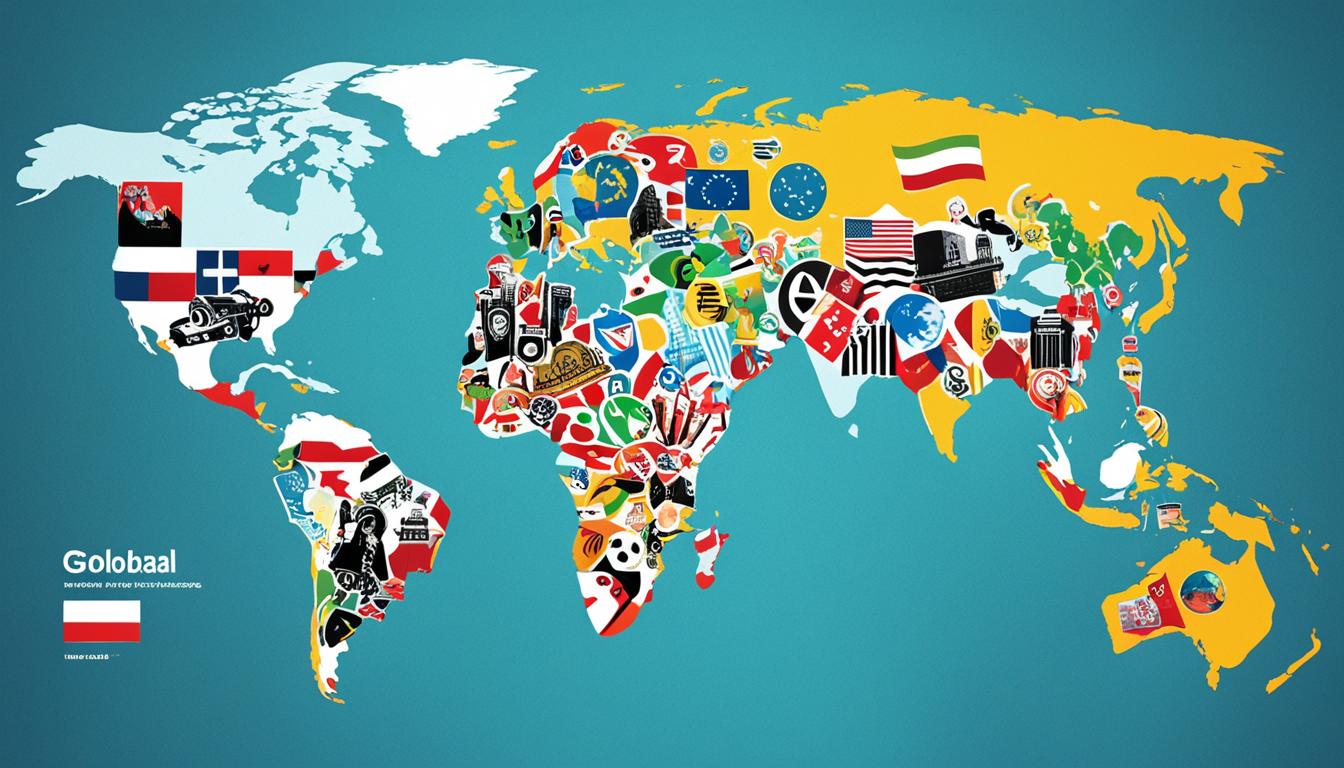The film industry remains one of the most intriguing and evolving sectors, shaping how stories are told and consumed globally. A broad film industry overview unravels this narrative ecosystem, constantly influenced by cinematic market trends and technological innovations. As stakeholders tap into the visual storytelling landscape, they adapt to the ever-changing demands and opportunities presented by the global movie industry review—a testament to the resilience and resourcefulness of those fueling the industry’s engine.
From independent auteurs to major studios, each entity plays a vital role in the perpetuation and transformation of cinema. The spectrum of visual storytelling extends far and wide, navigating through diverse cultural currents and audience preferences. Nonetheless, the industry’s core essence remains anchored in its ability to foster connection, empathy, and understanding on an unprecedented scale.
Key Takeaways
- Comprehensive understanding of the film industry’s complexity is imperative for success.
- Technological advancement and consumer behavior are pivotal in shaping cinematic experiences.
- Emerging market trends offer valuable insights into the changing landscape of global cinema.
- The global movie industry’s growth is accelerated by the increased visibility of diverse content.
- Strategic intelligence is essential for stakeholders navigating the competitive nature of film production and distribution.
- Localized storytelling continues to gain significance as international films gain wider audiences.
How would you describe the film industry?
The film industry is akin to a vast, pulsating network that transcends geographical boundaries and cultural divides. Its evolution is a testament to human creativity and technological triumph, morphing from the era of silent movies to today’s digital masterpieces. This sector is not just about entertainment; it’s an amalgamation of entertainment industry insights, film production descriptions, and a medium that reflects the human experience through global storytelling.
The Evolution and Current State of Cinema
As we review the growth trajectory of movies, we find that the earliest flickering images have been transformed into global cinematic feats, reaching millions with powerful narratives. The Hollywood insights gathered over the years have played a pivotal role in shaping what we see on screens today. Complementing this is a global movie industry review that captures diverse audience preferences, creating a marketplace that is both inclusive and varied.
One of the remarkable aspects of cinema’s current state is its diversity, as English, Chinese, Spanish, and Russian films capture the lion’s share of the market while simultaneously valuing each narrative’s uniqueness. Such a transformation within global storytelling signifies a universal language that transcends words.
Global Influence and Cultural Significance
Film has always been a significant cultural force, particularly emanating from Hollywood, setting the bar high for cinematic quality and innovation. Hollywood insights reveal trends and norms that often become global phenomena, underscoring the domain’s profound cultural impact. It is not just a mirror to society but also a catalyst for change and a bridge for intercultural connectivity.
The international reach of films today celebrates a spectrum of genres and languages that resonate with audiences worldwide. This speaks to a fundamental human connection through stories, supporting the idea that cinema is, indeed, a universal art form.
Innovative Trends Shaping Modern Filmmaking
Today’s filmmakers are adeptly riding the wave of innovative trends, leveraging technological advancements that redefine the boundaries of creativity and production. From special effects that bring the fantastical to life to digital platforms that democratize film distribution, the industry is in a state of perpetual motion.
The rise of streaming services exemplifies this shift, bridging the gap between storytellers and their audiences in unprecedented ways. This technological progression is also reflected in the way global audiences are now able to engage with stories that were once beyond their reach, heralding a new era of global accessibility and consumption in cinema.
Deconstructing the Film Production Landscape
The film production description is more than a mere behind-the-scenes glimpse; it’s an intricate dance of creativity and commerce. From the embryonic stages of pre-production to the final touches in post-production, each phase presents its own set of challenges and opportunities for all players involved.
Understanding the movie business analysis requires delving into the myriad components that make up the production landscape. Smaller, transformative companies often find themselves creatively involved yet financially restrained. This is especially true in the realm of distribution, where these companies compete against more established, well-funded entities.

Despite the hurdles, these burgeoning companies contribute richly to the vibrancy and diversity of the film industry. A closer look at the various roles within a production company reveals a tapestry of skills and inputs, each critical to the successful realization of a cinematic project.
- Pre-Production: Development, Financing, and Planning
- Production: Execution, Filming, and Directing
- Post-Production: Editing, Visual Effects, and Scoring
- Distribution: Marketing, Sales, and Exhibition
To illustrate how these components interact, consider the following comparative analysis:
| Aspect | Large Production Companies | Small Production Companies |
|---|---|---|
| Financial Resources | Substantial budget and investor backing | Limited budgeting and high reliance on external funding |
| Creative Control | Potential compromises for commercial viability | Higher degree of creative freedom and experimentation |
| Market Reach | Global distribution networks | Focused, niche market strategies |
| Technological Access | Latest equipment and software | Dependent on cost-effective solutions |
| Employment Opportunities | Diverse roles with hierarchical structure | Dynamic roles requiring a breadth of skills |
The economic activities and market forces inherent in film production influence employment trends, adoption of emerging technologies, and overall strategic direction. Aspiring filmmakers and industry professionals must appreciate these nuances to navigate the sector adeptly, whether heading a startup or steering a production titan.
“While big studios may hold the clout, it is often the smaller, dynamic companies that push the boundaries of storytelling and innovation within the film production landscape.”
Conclusion
In navigating the complex tapestry that is the film industry, one cannot underestimate the value of strategic market intelligence. Rooted deeply within the cinematic trade, this analytical power tool provides a detailed dissection of market forces, offering critical insights that transcend mere speculation. The insights gleaned from strategic market intelligence are essential for maneuvering the film industry’s evolving landscape, be it through informed market entry strategies, competitive analyses, or seizing stockpiled opportunities hidden within the folds of the entertainment tapestry.
Critical Role of Strategic Market Intelligence
Market intelligence serves as the compass for stakeholders seeking to navigate the unpredictable currents of the film industry. With a blend of global reach and local expertise, it delivers a market analysis extraordinarily attuned to the sector’s vibrancy and offers elevated film industry insights indispensable for decision-making. As competitive edges are whittled and sharpened in this space, a clear and proactive use of strategic market intelligence positions businesses not just to compete, but to set the pace for industry transformation.
Future Prospects: Sustainability and Transformation
The horizons of the film industry are continually expanding, with sustainability and transformative practices becoming not just ideals, but benchmarks for future progression. Reports advocate for a broader leadership spectrum within organizations, which can drive more considerate hiring structures and an uplifting environment for diverse talent groups. This approach to inclusivity nurtures sustainability and endorses a transformative ecosystem within the industry. In light of the recent upheavals, such as the pandemic’s economic impact, stability and robust support structures are imperative. Future prospects will hinge on effectively marshalling resources, development strategies, and savvy market intelligence, to cultivate an entertainment realm that is both durable and agile against the backdrop of global economic currents and cultural metamorphoses.
FAQ
How would you describe the film industry?
The film industry is a dynamic and evolving landscape of visual storytelling that spans the globe. It encompasses the creation, production, marketing, and distribution of films and is characterized by its blend of artistic expression and commercial enterprise. The industry reflects cultural narratives, consumer behavior, technological innovation, and economic challenges. It’s a sprawling network that includes everything from independent filmmakers to major Hollywood studios, all contributing to the cinematic tapestry that entertains and informs audiences worldwide.
What are the current cinematic market trends?
Current cinematic market trends include the rise of streaming platforms and on-demand services, which have disrupted traditional distribution models and expanded global access to content. Additionally, there is an increased appetite for diverse storytelling that reflects a wider range of experiences and perspectives. Technological advancements continue to shape the industry as well, with virtual reality, high-definition streaming, and an emphasis on high-quality visual effects becoming more prevalent. The industry has also seen a surge in the popularity of certain genres, like thrillers, which resonate with a broad audience.
What is the global movie industry review?
The global movie industry is experiencing significant growth, with emerging markets contributing to an increasingly diverse and expansive international box office. While Hollywood remains a central figure, other regions, such as Asia and Europe, are gaining influence due to their robust local film industries and their drive for cross-cultural collaborations. The rise of international co-productions, the prevalence of film festivals showcasing global talent, and the recognition of non-English language films at major award shows underscore the global industry’s interconnected and vibrant nature.
How do innovative trends influence modern filmmaking?
Innovative trends have a profound impact on modern filmmaking, pushing the boundaries of what’s possible in visual storytelling. Advancements in special effects and CGI have opened new creative horizons, allowing filmmakers to bring previously unimaginable worlds and narratives to life. The adoption of digital cinematography and post-production techniques has streamlined the filmmaking process and improved efficiency. Moreover, the democratization of film equipment and software enables a greater number of voices to participate in the artform. The integration of data analytics and audience insights also drives more targeted and personalized content creation.
Can you provide a film production description?
Film production is the process of developing a film from its initial conception through its eventual distribution to audiences. It can be broadly divided into three main phases: pre-production, production, and post-production. Pre-production involves scriptwriting, casting, budgeting, location scouting, and planning for the shoot. Production is the actual filming of the movie, which involves directors, actors, cinematographers, and crew working to capture the script on film or digital media. Post-production encompasses editing, visual effects work, sound design, and scoring. The end product is a film ready for screening in theaters or distribution through various media platforms.
Why is strategic market intelligence crucial for the film industry?
Strategic market intelligence is essential for the film industry because it provides data-driven insights that can inform decision-making processes. This type of intelligence includes understanding audience preferences, tracking competitive movements, analyzing box office performance, and staying informed about technological advancements and regulatory changes. It empowers industry stakeholders to make knowledgeable choices about production, marketing, and distribution strategies, thereby increasing the likelihood of a film’s commercial success and cultural impact.
What does the future hold for film industry sustainability and transformation?
The future of film industry sustainability and transformation lies in adapting to changing consumer habits, technological advancements, and global market shifts. This includes embracing environmental best practices on set, fostering diversity and inclusivity within the industry, and developing new economic models in response to the rise of digital platforms. The industry must also cultivate resilience to withstand volatility, such as shifts in consumer demand or disruptions like the pandemic. By integrating sustainable practices and focusing on transformation, the film industry can ensure its ongoing relevance and success in the entertainment landscape.






